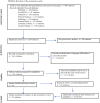The Relationship Between Alexithymia and Emotional Awareness: A Meta-Analytic Review of the Correlation Between TAS-20 and LEAS
- PMID: 29713295
- PMCID: PMC5911526
- DOI: 10.3389/fpsyg.2018.00453
The Relationship Between Alexithymia and Emotional Awareness: A Meta-Analytic Review of the Correlation Between TAS-20 and LEAS
Abstract
Background: Alexithymia and emotional awareness may be considered overlapping constructs and both have been shown to be related to psychological and emotional well-being. However, it is not clear how the constructs relate to each other empirically or if they may overlap more or less in different populations. The aim of this review was therefore to conduct a meta-analysis of correlations between the most commonly used measures of alexithymia (i.e., the self-report instrument Toronto Alexithymia Scale; TAS-20) and emotional awareness (i.e., the observer-rated instrument Level of Emotional Awareness Scale; LEAS) and to explore potential moderators of their relationship. Methods: Electronic databases were searched for studies published until the end of February 2018. Study samples were coded as medical conditions, psychiatric disorders and/or healthy controls and sample mean age and gender distribution were extracted. Correlations between the TAS-20 and the LEAS were subjected to a random effect of meta-analysis and moderators were explored in subgroup analyses and meta-regressions. Publication bias was considered. Results: 21 studies reporting on 28 independent samples on correlation analysis were included, encompassing a total of 2857 subjects (57% women). The aggregated correlation between TAS-20 and LEAS was r = -0.122 (95% CI [-0.180, -0.064]; Z = -4.092; p < 0.001), indicating a significant, but weak, negative relationship between the measures. Heterogeneity was moderate, but we found no indication of significant differences between patients with medical conditions, psychiatric disorders or healthy controls, nor that mean age or percentage of female subjects moderated the relationship. The overall estimate became somewhat weaker after adjusting for possible publication bias. Conclusions: Our results indicate that TAS-20 and LEAS measure different aspects of emotional functioning. The small overlap suggests that alexithymia and emotional awareness are distinct constructs of emotional well-being. Clinicians need to assess both aspects when considering treatment options for individual patients. Moreover, from the clinical standpoint, an easy reliable and valid way of measuring emotional awareness is still needed. More research should be focus on the differences between alexithymia and emotional awareness in specific conditions, but also how to integrate self-report instrument and observed based measures in a clinical situation.
Keywords: LEAS; TAS-20; alexithymia; level of emotional awareness; meta-analysis; toronto alexithymia scale.
Figures
Similar articles
-
Differences in alexithymia and emotional awareness in exhaustion syndrome and chronic fatigue syndrome.Scand J Psychol. 2017 Feb;58(1):52-61. doi: 10.1111/sjop.12332. Epub 2016 Sep 30. Scand J Psychol. 2017. PMID: 27686801
-
Emotional awareness deficits in inpatients of a psychosomatic ward: a comparison of two different measures of alexithymia.Psychosom Med. 2005 May-Jun;67(3):483-9. doi: 10.1097/01.psy.0000160461.19239.13. Psychosom Med. 2005. PMID: 15911914
-
[French validation study of the levels of emotional awareness scale].Encephale. 2002 Jul-Aug;28(4):310-20. Encephale. 2002. PMID: 12232540 French.
-
Sociodemographic correlates of alexithymia.Compr Psychiatry. 1998 Nov-Dec;39(6):377-85. doi: 10.1016/s0010-440x(98)90051-7. Compr Psychiatry. 1998. PMID: 9829146 Review.
-
The association between alexithymia as assessed by the 20-item Toronto Alexithymia Scale and depression: A meta-analysis.Psychiatry Res. 2015 May 30;227(1):1-9. doi: 10.1016/j.psychres.2015.02.006. Epub 2015 Feb 19. Psychiatry Res. 2015. PMID: 25769520 Review.
Cited by
-
Alexithymia may explain the relationship between autistic traits and eating disorder psychopathology.Mol Autism. 2020 Aug 5;11(1):63. doi: 10.1186/s13229-020-00364-z. Mol Autism. 2020. PMID: 32758290 Free PMC article.
-
Development and validation of the Korean version of the Reading the Mind in the Eyes Test.PLoS One. 2020 Aug 31;15(8):e0238309. doi: 10.1371/journal.pone.0238309. eCollection 2020. PLoS One. 2020. PMID: 32866184 Free PMC article.
-
Emotion word repertoire in the adult attachment interview is linked to reduced suicide attempts in patients with borderline personality disorder.Heliyon. 2024 Aug 24;10(17):e36907. doi: 10.1016/j.heliyon.2024.e36907. eCollection 2024 Sep 15. Heliyon. 2024. PMID: 39281595 Free PMC article.
-
Identifying and regulating emotions after acquired brain injury: the role of interoceptive sensibility.Front Psychol. 2023 Dec 21;14:1268926. doi: 10.3389/fpsyg.2023.1268926. eCollection 2023. Front Psychol. 2023. PMID: 38179500 Free PMC article.
-
Development and validation of a computer program for measuring emotional awareness in German-The geLEAS (German electronic Levels of Emotional Awareness Scale).Front Psychiatry. 2023 Mar 23;14:1129755. doi: 10.3389/fpsyt.2023.1129755. eCollection 2023. Front Psychiatry. 2023. PMID: 37032926 Free PMC article.
References
LinkOut - more resources
Full Text Sources
Other Literature Sources


